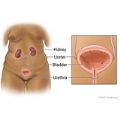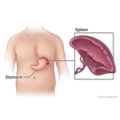Computed Tomography (CT) Scan of the Body
Test Overview
A computed tomography (CT) scan uses X-rays to make detailed pictures of structures inside of the body.
During the test, you will lie on a table that is attached to the CT scanner, which is a large doughnut-shaped machine. The CT scanner sends X-rays through the body area being studied. Each rotation of the scanner provides a picture of a thin slice of the organ or area. All of the pictures are saved as a group on a computer. They also can be printed.
In some cases, a dye called contrast material may be used. It may be put in a vein (I.V.) in your arm. Or it may be placed into other parts of your body (such as the rectum or a joint) to see those areas better. For some types of CT scans, you drink the dye. The dye makes structures and organs easier to see on the CT pictures.
A CT scan can be used to study all parts of your body, such as the chest, belly, pelvis, or an arm or leg. It can take pictures of body organs, such as the liver, pancreas, intestines, kidneys, bladder, adrenal glands, lungs, and heart. It also can study blood vessels, bones, and the spinal cord.
Why It Is Done
CT scans are used to study areas of the body and the arms or legs.
- Chest (thorax). A CT scan of the chest can look for problems with the lungs, the heart, the esophagus, or the major blood vessel (aorta) or the tissues in the center of the chest. Some common chest problems a CT scan may find include infection, lung cancer, a pulmonary embolism, and an aneurysm. It also can be used to see if cancer has spread into the chest from another area of the body.
- Abdomen. A CT scan of the abdomen can find cysts, abscesses, infection, tumors, an aneurysm, enlarged lymph nodes, foreign objects, bleeding in the belly, diverticulitis, inflammatory bowel disease, and appendicitis.
- Urinary tract. A CT scan of the kidneys, ureters, and bladder is called a CT KUB or CT urogram. This type of scan can find kidney stones, bladder stones, or blockage of the urinary tract. A special type of CT scan, called a CT intravenous pyelogram (IVP), uses injected dye (contrast material) to look for kidney stones, blockage, growths, infection, or other diseases of the urinary tract.
- Liver. A CT scan can find liver tumors, bleeding from the liver, and liver diseases. A CT scan of the liver can help find the cause of jaundice.
- Pancreas. A CT scan can find a tumor in the pancreas or inflammation of the pancreas (pancreatitis).
- Gallbladder and bile ducts. A CT scan can be used to check for blockage of the bile ducts. Gallstones sometimes show up on a CT scan. But other tests, such as ultrasound, usually are used to find problems with the gallbladder and bile ducts.
- Adrenal glands. A CT scan can find tumors or enlarged adrenal glands.
- Spleen. A CT scan can be used to check for an injury to the spleen or the size of the spleen.
- Pelvis. A CT scan can look for problems of organs in the pelvis. These include the uterus, ovaries, fallopian tubes, prostate gland, and seminal vesicles.
- Arm or leg. A CT scan can look for problems of the arms or legs, such as the shoulder, elbow, wrist, hand, hip, knee, ankle, or foot.
Other uses for a CT scan
A CT scan may be used to help do a procedure. For example, the doctor may use CT to guide a needle during a tissue biopsy or to guide the proper placement of a needle to drain an abscess.
For people with cancer, a CT scan can help find out how much the cancer has spread.
How To Prepare
In general, there's nothing you have to do before this test, unless your doctor tells you to.
Tell your doctor if you get nervous in tight spaces. You may get a medicine to help you relax. If you think you'll get this medicine, be sure you have someone to take you home.
If you have a CT scan of your belly, you may be asked to not eat any solid foods starting the night before your scan. For a CT scan of the belly, you may drink contrast material. For some CT scans, you may need a laxative or an enema before the test.
How It Is Done
You may need to take off any jewelry. You will need to take off all or most of your clothes, depending on which area is studied. You may be able to wear your underwear for some scans. You will be given a gown to use during the test.
During the test, you will lie on a table that is attached to the CT scanner.
The table slides into the round opening of the scanner, and the scanner moves around your body. The table will move while the scanner takes pictures. You may hear a click or buzz as the table and scanner move. It is very important to lie still during the test.
During the test, you may be alone in the scan room. But the technologist will watch you through a window. You will be able to talk to them through a two-way intercom.
How long the test takes
The test will take about 30 to 60 minutes. Most of this time is spent getting ready for the scan. The actual scan only takes a few minutes.
Watch
How It Feels
The test will not cause pain, but some people feel nervous inside the CT scanner.
If a medicine to help you relax (sedative) or dye is given through an I.V., you may feel a quick sting or pinch when the I.V. is started. The dye may make you feel warm and flushed and give you a metallic taste in your mouth. Some people feel sick to their stomach or get a headache. Tell the technologist or your doctor how you are feeling.
Risks
The chance of a CT scan causing a problem is small.
- There is a chance of an allergic reaction to the dye (contrast material).
- If you breastfeed and are concerned about whether the contrast material used in this test is safe, talk to your doctor. Most experts believe that very little dye passes into breast milk and even less is passed on to the baby. But if you are concerned, you can stop breastfeeding for up to 24 hours after the test. During this time, you can give your baby breast milk that you stored before the test. Don't use the breast milk you pump in the 24 hours after the test. Throw it out.
- There is a risk of damage to cells or tissue from being exposed to radiation, including the small amounts used in CTs, X-rays, and other medical tests. Over time, exposure to radiation may cause cancer and other health problems. But in most cases, the risk of getting cancer from being exposed to small amounts of radiation is low. It is not a reason to avoid these tests for most people.
Results
Complete results usually are ready for your doctor in 1 to 2 days.
CT scan
Normal:
- The organs and blood vessels are normal in size, shape, and location. No blood vessels are blocked.
- No foreign objects (such as metal or glass fragments), growths (such as cancer), inflammation, or infections are present.
- No bleeding or collections of fluid are present.
Abnormal:
- An organ is too large or too small, damaged, or infected. Abscesses are present.
- Foreign objects (such as metal or glass fragments) are present.
- Kidney stones or gallstones are present.
- Growths (such as tumors) are seen in the colon, lungs, ovaries, liver, bladder, kidneys, adrenal gland, or pancreas.
- A CT scan of the chest shows a pulmonary embolism, fluid in the lungs, or infection.
- An aneurysm is present.
- Blockage is found in the intestines or in the bile ducts.
- A CT of the belly shows inflammatory bowel disease or diverticulitis.
- Lymph nodes are enlarged.
- One or more blood vessels are blocked.
- A growth, fracture, infection, or other problem is found in an arm or leg.
Related Information
Credits
Current as of: July 31, 2024
Author: Ignite Healthwise, LLC Staff
Clinical Review Board
All Healthwise education is reviewed by a team that includes physicians, nurses, advanced practitioners, registered dieticians, and other healthcare professionals.
Current as of: July 31, 2024
Author: Ignite Healthwise, LLC Staff
Clinical Review Board
All Healthwise education is reviewed by a team that includes physicians, nurses, advanced practitioners, registered dieticians, and other healthcare professionals.










